
10 minute read
When I first started working on my first online course, I was working full time at an office job and was the primary caregiver to my mother who was (and still is) fighting late stage cancer. During the best weeks, I could only find 2-4 hours a week to work on the course, often late in the evenings or early mornings. But my experience isn’t unique. Many new instructors, including many who went through our SFI program, had to find time between their day jobs, raising children, and everything else in life that throws a wrench into your plans.
That might not be best question to ask since you could technically make an online course over the weekend in a couple of hours but that doesn’t mean it’ll be a GOOD online course that generates consistent sales for you. The better question to ask is: “How much time does it take to make a GOOD online course?”
Short answer: Less than you might think. On average, you can expect to spend about 10 – 20 hours of work to create 1 hour of content. So for a 5-hour long course, that is 50 to 100 hours of total work
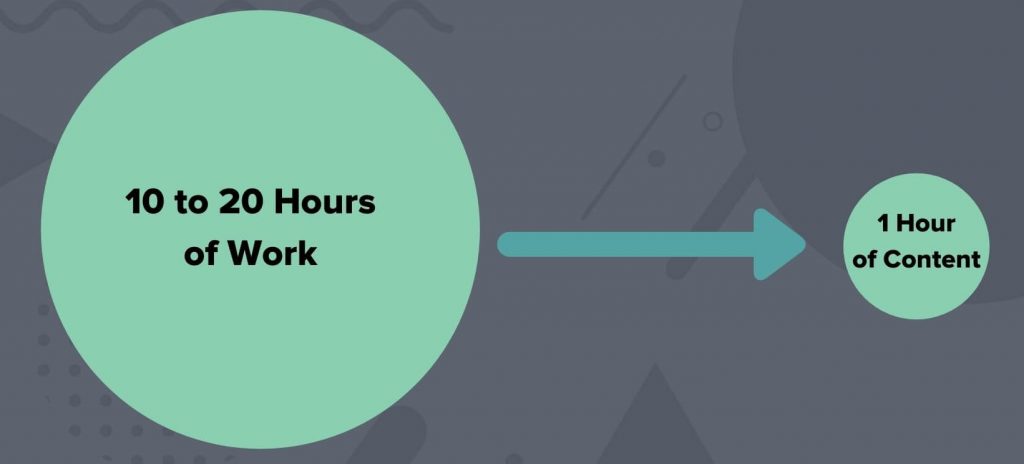
Long answer: it will vary based on many factors: how well versed you are on the topic, the length of the course you’re creating, how experienced you are in creating content for an online course, and what sales strategy you choose to adopt for promoting your course.
Only putting in 5 hours a week will take you longer to finish your course than if you could put in 15 or 20 hours. But sometimes, especially for first time instructors, 5 hours a week is all they could find in between full time work and other constraints on their time.
But five hours is also quite easy to find. When I made my first course, it took me over six months to make because I could only find about 5 hours a week on some evenings after work and on some weekends. I was working full time and acting as a primary caregiver to my ailing mother who was recently diagnosed with cancer at the time. I also had no idea what I was doing and I didn’t have a dedicated recording space. Today, if I were to make to redo my course from scratch with what I know now and with my dedicated recording space where all I have to do is switch my equipment on and press record on my remote, I can make a better version of my course in 4 weeks tops.
Many of our students who are working full time and raising young children also find it challenging but are generally able to finish producing their first course within 3 to 4 months for a 5 to 8 hour long course. Some students finish in 6 weeks putting in 20 plus hours per week while some take 6 months or longer putting in only 5 hours a week.
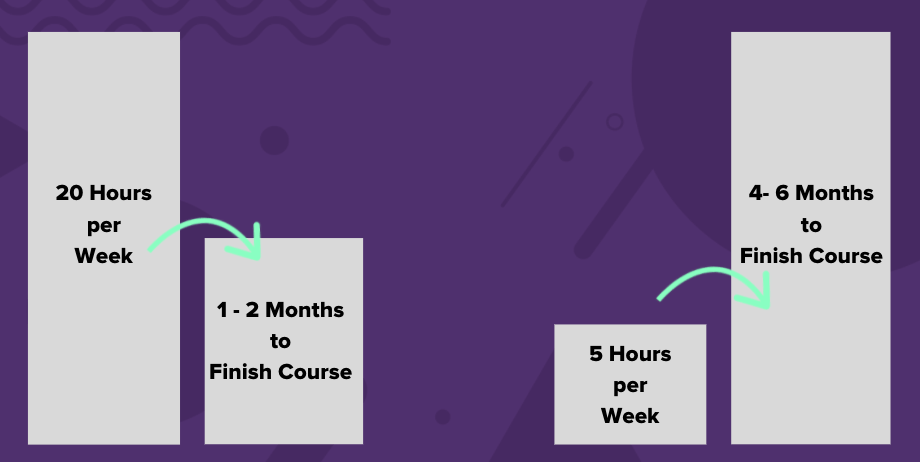
This shouldn’t be surprising: If it will take 10 hours of video content to fully cover your topic for your course, then that will take much longer to produce than a course that only requires 3 hours of video content. But starting out, many first time instructors have no idea how long their course should or need to be.
There are two simple ways to determine that. For instructors targeting marketplaces like Udemy, it’s as simple as finding their main competitors and ensuring that their new course covers all of the topics of their competitors plus something extra that helps their course stand out from the crowd. On marketplaces, longer courses tend to sell better so if your competition has courses covering the same topic with courses ranging from 2 to 5 hours long, then an 8 hour course that covers the same topic in more detail, with more examples, with more exercises, or just deeper coverage of subtopics will generally sell better.
For independent courses, length is less a factor for sales and more a factor for student satisfaction. In fact, independent courses could run the risk of being too long. One way to address this is to create mandatory and optional categories of content where the mandatory content is as precise and fast as possible while the optional content adds tremendous value. This is the approach we’ve taken with our Six Figure Instructor program, where we have our main content at about 8 hours long but we have over 30 hours of optional content that dives deep into subtopics that only appeal to a subset of our students.
When you’re making an online course for the first time, you’re doing the work that is needed to make your course but you will also need to learn how to make a course. And that takes time.
Learning how to research your competition, how to find resources to round out your curriculum, how to script your lectures in a concise and informative way that still sounds naturally like your voice, how to talk into a camera, how to use a teleprompter, how to plan and edit your videos, and dozens of more tasks. Some folks with related prior backgrounds in video production or having worked in front of a camera will certainly pick things up faster, but the rest of us will have to put in the time to get comfortable.
Even if you’ve worked in the industry for 30 years and have presented in front of 100s or 1000s of people, talking into a camera and making video content for online courses can still feel foreign. So while on average an instructor can expect to spend 10 hours working to produce each hour of content for their course, first time instructors should budget closer to 20 hours for every hour of content, just to accommodate the early learning curve involved.
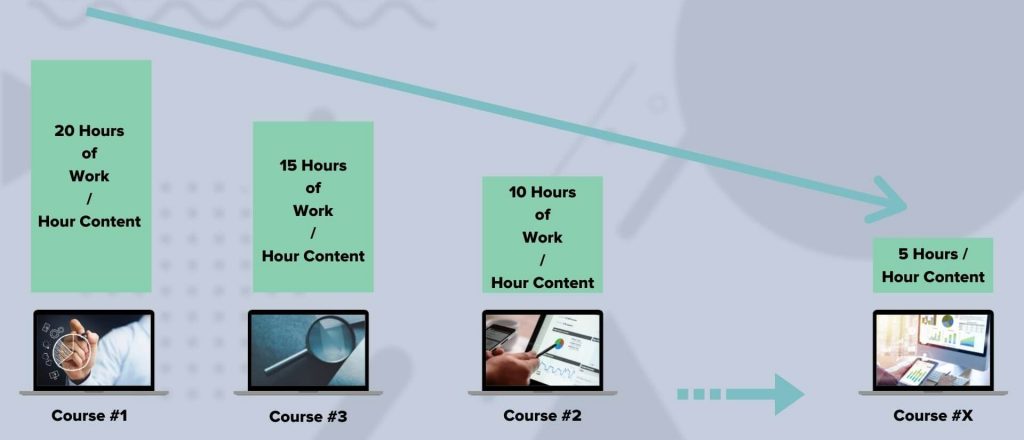
But the good news is that this is the slowest you will ever be at making an online course. As you get more experienced and refine your work flows, you could even cut it down to about 5 – 6 hours of work for every hour of content. That’s about where we’re at today after having made nearly 50 online courses between the two of us. We each found a process that works best for our teaching styles to maximize our efficiency.
After writing and refining your scripts for your lectures, it’s time to record. But you’ll need a space to record. Something that has a background that works for your style and your topic. Where you can set up proper lighting and record quality sound without a lot of noise or echo.
But having the space is one thing, making sure your equipment is set up the same for each recording session is another. It would be distracting to your students if your video quality or sound keeps changing from video to video. To do that, you must ensure that your entire setup from the positioning of your lights, camera, and microphone as well as their settings are all consistent across the recording sessions.
So what happens if you don’t have a dedicated recording space? Well, you’d then to set up and break down all of your equipment each time, which could take an hour each way. On top of that, to ensure your settings are consistent, you’d need to test your video and audio quality before recording. I’m ashamed to admit I’ve lost close to a dozen recording sessions because something was awry with my setup without me knowing. A battery died in a mic and I had 6 hours of video without any audio—an entirely wasted session (and hence why I use dedicated AC power to my equipment and remove batteries entirely from my process).
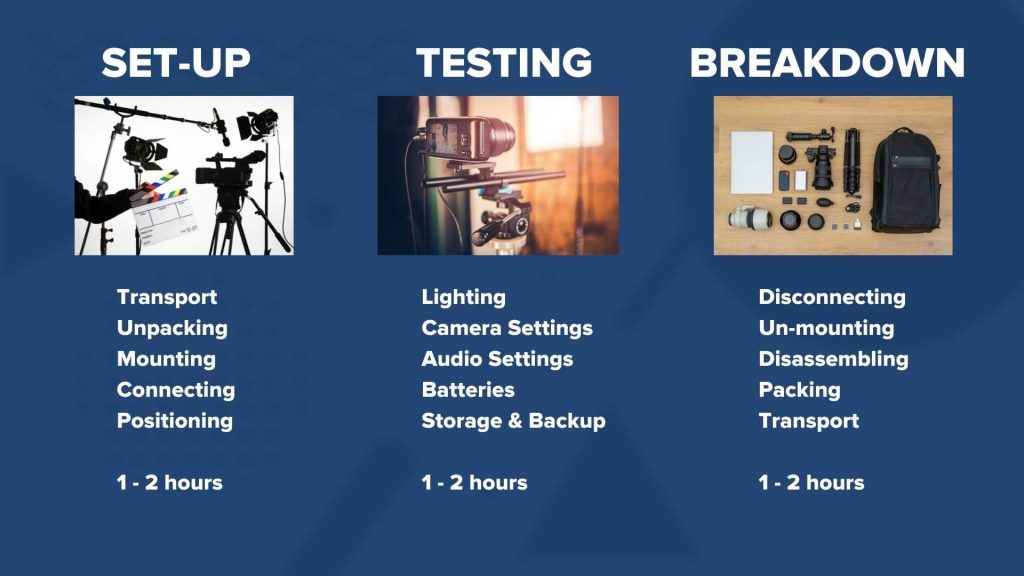
This cannot be overstated. The time and effort involved in breaking down and setting up and testing repeatedly could add 3 – 6 hours in additional work for EACH RECORDING SESSION. This could easily more than triple the amount of time it takes you to finish your recordings.
One of the most time-consuming aspects of making an online course is the research, curriculum development, and lecture script writing involved. The more familiar you are with the topic and the more relevant experience you have with the topic, the easier it is to doing this work. It means less time figuring out what you should include or exclude in your curriculum or your lectures. However, that doesn’t mean that you have to be an expert to make a great online course on a topic.
As we’ve mentioned in another post, you don’t need to be an expert to make a great online course but having some background can certainly help you speed up your development process. Often, not having advanced expertise means you’re able to better relate to the beginner learner and thus better able to determine what foundational content to cover that best serves your beginner students.
With online courses, there are two broad sales strategies that most instructors will choose between: to sell their courses on marketplaces like Udemy or to sell them independently on their own websites.
With marketplaces, you only need to worry about the course content. Once you finish your course and upload it, there is little for you do as an instructor other than to answer student questions and make occasional updates as needed.
But with independent courses, finishing your course content is only half the journey. You’ll still need to find your audience, promote your course to them, and convince them to purchase. This process typically becomes building an entire sales funnel that involves driving traffic (both paid and organic) to a webinar that ultimately pitches your course for sale to your leads. Getting this funnel up and optimizing it can take both money and time.
Courses for marketplaces generally need to be longer and more detailed since you’ll be competing with many others on an open marketplace and length is one of the key drivers of perceived value from prospective students. Independent courses can generally be shorter but the work that is required to build out a sales funnel can often take much more time.
For example, Evan and I both spent three and six months on making our longest Udemy courses, respectively. And since publishing them many years ago, we spend on average less than an hour a month maintaining these courses.
Below is a breakdown of how much time it took us to make our longest Udemy courses and ROI has been:
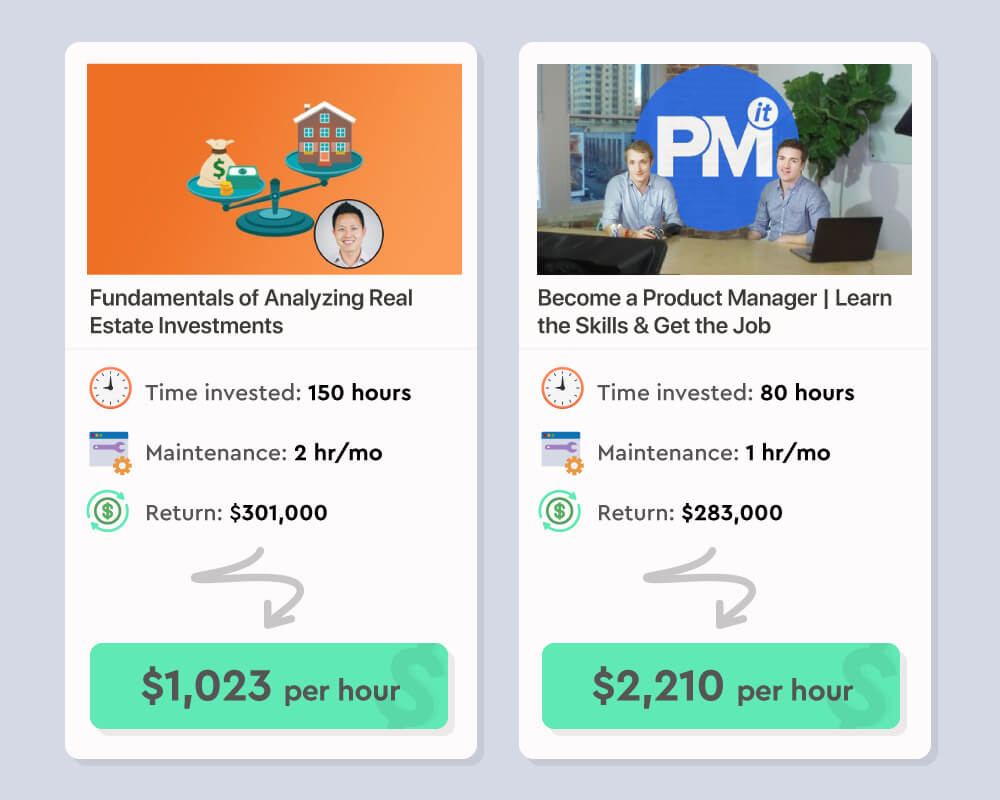
For my indie course on Airbnb hosting however, it took me two months to make the course but another 6 months to build out the initial sales funnel, as it required testing and retooling to figure out what would work. And it requires that I spend nearly an hour a day to maintain my course as the higher price point for this course meant a higher level of touch with my students.
Subscribe now for free tools, strategies and resources